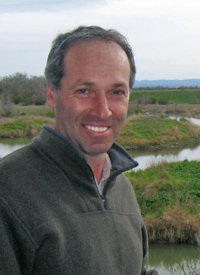Darrell Slotton

Working for years on a mercury monitoring project in the beautiful Cache Creek has well acquainted Darell Slotton with both the ecological and mercury concerns resulting from extensive gravel mining in the area. As a mercury researcher, community member, and friend to the creek, Slotton is deeply concerned for both human and environmental health. Ultimately, he envisions more habitat restoration, namely wetlands, coupled with mercury mitigation strategies along Cache Creek.
Can you tell me more about how you were involved with this land?
My fondest feelings about this place are over a man named Jan Lowrey, who was the god of this place. He got the whole thing going. It was his baby. He was single-minded in wanting to restore habitat here. He just saw this big, ugly open pit and in his mind he saw what could turn into a beautiful wetland restoration with kids coming out from school regularly.
What impact has the preserve had on you or had on people that you know?
I don’t know if the place has had a big impact on me personally, but I love to see kids coming out… They’re bored and messing around with each other, then all of a sudden they get fixated on this place [The Cache Creek Nature Preserve (CCNP)]. What a great experience to have this regular option for kids who wouldn’t otherwise come out and get a little hooked on nature.”
Why is this habitat important? What can be done? What should we do?
Almost everything about wetlands is great for the environment. It’s good for water pollution in general. Water is cleaner after filtering through a wetland. Mercury is the monkey wrench in this whole thing. Wetlands create the situation for the production of methyl mercury. This place [CCNP] was important because it was an opportunity to experiment and see what’s really going on and how can we deal with this cross purpose of putting in wetland restoration and dealing with mercury at the same time.
And so in regards to mercury and habitat restoration, what are some things that could be or should be done?
Sure, what to do? To help things as we move forward. Well, the mercury’s there. There’s no getting around that. There’s enough there to cause a problem and some of the things that can be done is knowing if you’re going to put in a wetland and those microbes that are creating the methyl mercury. Manage your water release. Don't just have it be a flow through system adding increased methyl mercury to the system downstream, you can keep it localized… There’re ways to keep the oxygen levels up through simple disruption of the thermocline in the ponds (it’s called). So, there’s very inexpensive ways of keeping the water turned around so that you don’t develop this anaerobic condition in the water itself, which when you get methyl mercury produced right there in the water column, it goes straight into the fish, so there’s ways to avoid that. There’re many other things too.
Is there anything else you want to tell me about mercury or anything related to that.
The real problem is that mercury bio accumulates the way DDT does. It becomes more concentrated at each step of the food chain and so it really becomes an issue at the very top of the food chain and big predatory fish. Old, big predatory fish in this area would a big large mouth bass. In the delta, it would be a big striped bass. In the ocean, it would be a big tuna, or shark or swordfish. It’s not all people. It’s really a problem for developing nervous tissue and that means babies. That’s the big concern. It’s the infant in the womb.
Do you have anything else that you would like to elaborate on in regards to the Cache Creek Nature Preserve or its position within society?
This is a model, a beautiful model, of what could be done with a series of ponds all the way to the coast range, here along Cache Creek… I think we’ve got the tools now to manage those ponds so that they don’t create a problem downstream.
To download the audio, right click on the audio link above and scroll to "Save link as . . ." and choose the directory where you want to store the mp3. In Windows, you may have to use Control + S to select the link.